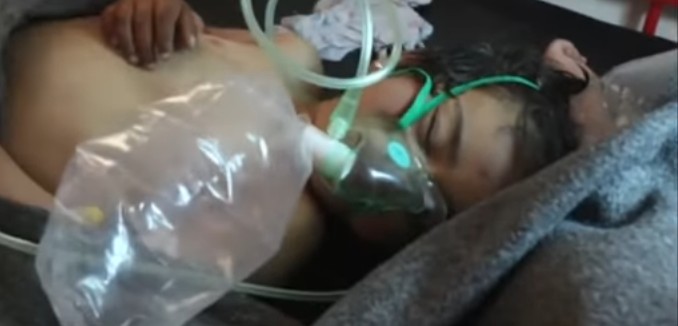Two recent reports highlighted the problem of using diplomacy alone to disarm rogue states.
On October 15, the BBC published an in-depth investigation that showed “for the first time the extent to which chemical weapons have been crucial to his war-winning strategy.” According to the report, the BBC determined that “there is enough evidence to be confident that at least 106 chemical attacks have taken place in Syria since September 2013, when the president signed the international Chemical Weapons Convention (CWC) and agreed to destroy the country’s chemical weapons stockpile.”
Many of these attacks were carried out with chlorine, which is a dual-use substance that has legitimate uses, though its use as a weapon is prohibited. Chlorine was determined to be the chemical used in 79 of the 106 attacks. But sarin was used in two of the deadliest attacks to date: the August 2013 attack on East Ghouta that claimed at least 1,300 lives and the April 2017 attack on Khan Sheikhoun in the Idlib province that killed at least 80 people.
The first of those attacks was what prompted the world to act and agree upon a deal to force the regime of Bashar al-Assad to sign the CWC and get rid of all of its chemical weapons. The second attack came nearly three years after then-Secretary of State John Kerry said, “With respect to Syria, we struck a deal where we got 100% of the chemical weapons out.”
Clearly, if Assad still had access to sarin in 2017, the chemical weapons deal did not succeed in forcing him to get rid of his complete chemical weapons stockpile.
“All we could do was to verify what we’d been told was there,” Julian Tangaere, the former head of the Organization for the Prohibition of Chemical Weapons mission to Syria, which was charged with overseeing the removal of the stockpile, told the BBC. “The thing about the Chemical Weapons Convention is it’s all based on trust.”
Tangaere’s explanation demonstrates the weakness in the chemical weapons deal. It depended on Assad being truthful and on the inspectors having full access to the Syrian chemical weapons stockpile. Assad was able to control the access of the inspectors and thus shield a portion of his deadly arsenal.
A similar picture emerges from the 2015 nuclear deal with Iran. While many suspected that Iran would cheat on the deal, that Iran was cheating wasn’t clear until Israeli Prime Minister Benjamin Netanyahu revealed that Iran had kept an archive of files, documenting its extensive nuclear weapons research in April of this year.
In his presentation, Netanyahu said that the archive proved that Iran lied about having a nuclear weapons program, showed Iran’s intent to reconstitute the effort in the future, and confirmed that Iran lied about having come clean to the International Atomic Energy Agency (IAEA) about its past nuclear work.
The Institute for Science and International Security, which has reviewed many of the documents recovered by Israel, assessed in a study released a week after the BBC report:
The evidence reinforces that Iran was violating the NPT in the early 2000s in a more significant manner than previously understood and fully intended at that time to continue work toward having the option to build nuclear weapons and deceive the IAEA in that endeavor. There is no proof that Iran has abandoned its goal of building nuclear weapons, only that it has accepted that its projects and plans are put on the shelf.
The institute also faulted the IAEA for “lack of adequate inspection” of the Parchin site, where Iran tested methods for detonating nuclear devices, as well as “the failure to fold new information into the IAEA’s broader challenge of ensuring that Iran’s nuclear program is actually peaceful.”
It wasn’t just the Israeli discovery of the Iranian nuclear archive that showed that the IAEA inspectors did not have the latitude to inspect every suspected nuclear site. Yukiya Amano, the Director General of the IAEA, acknowledged in September 2017 that his agency did not have the ability to monitor Iran’s compliance with items mentioned in Section T of the nuclear deal. Section T governs “activities which could contribute to the development of a nuclear explosive device.”
Last year, an IAEA official confirmed it would not ask for access to Iranian military sites so as not to give the U.S. an “excuse” to “bring down the deal,” even though access to military sites, including Parchin, was described by Amano as being necessary for the deal to be effective.
Syria, when it signed the CWC, knew that it could control the access inspectors would have to its illicit chemical stockpiles. Similarly, Iran established, even before the deal was implemented, that it would not allow inspectors physical access to military sites.
While diplomacy is preferable to war in the abstract, the diplomacy which was employed in the 2013 chemical weapons deal with Syria, and the 2015 nuclear deal with Iran, failed to force either rogue regime to give up their illicit programs.
The result in Syria was devastating, as hundreds of thousands were killed and millions more displaced, and, as the BBC report observed, Assad was able to salvage his rule.
As it appears, the direct results of Iran’s cheating have not yet been as catastrophic. However, unless the international community demands absolute compliance with the nuclear deal by Iran, the Islamic Republic will just bide its time until it can resume developing its weapons of terror. The European Union should not be looking at ways to maintain business as usual with Iran, but ways to ensure that it complies with the demands of the nuclear deal, including joining the United States in re-imposing all sanctions that had been lifted as part of the nuclear deal.
[Photo: euronews (in English) / YouTube ]




